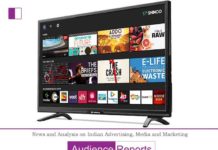Although both platforms are different in nature with YouTube being a user-generated intermediary and JioCinema being a content platform and an aggregator, both are comparable when it comes to competing for advertisers’
Udhay Shankar, co-founder of Bodhi Tree Systems and director at Viacom18 boldly pitched JioCinema as the alternative for TV, recently.
On the other hand, YouTube touted CTV as its fastest-growing screen in the past five years besides having the largest reach.
Globally, the top 5 companies control about 50% of wealth and all of them are digital-led companies. Well, YouTube’s parent company Alphabet is one of them.
Realising this, Indian business conglomerate Reliance Industries invested big in digital infrastructure and capabilities and Jio is now leading the group’s wealth.
While JioCinema, the digital content arm of Reliance, may be eyeing to eat into TV adex, its primary challenge would be to claim a larger pie in the adex going to digital.
Most of the brands running their TVCs on YouTube would be JioCinema’s primary target clients.
Although both platforms are different in nature with YouTube being a user-generated intermediary and JioCinema being a content platform and an aggregator, both are comparable when it comes to competing for advertisers’ money.
The first question that comes to mind is whether JioCinema can overshadow YouTube in terms of reach and advertisers’ interest in the times to come.

According to Shashank Srivastava, Senior Executive Director, Marketing and Sales, Maruti Suzuki, “YouTube India has over 567 million monthly active users (MAUs) in India whereas for JioCinema the number is over 221 million MAUs. However, for live events like IPL 2023, the cumulative reach for JioCinema went as high as 450 million (as claimed by Jio). So, on an overall level, while the active user base of YouTube in terms of MAUs is 2.5 times that of JioCinema, the latter catches up in terms of reach during live cricket events.”
JioCinema recorded 100% growth in FY23 to reach 221 million MAUs. On the other hand, YouTube grew 18% to 567 million MAUs.
“In terms of potential, JioCinema is growing at a phenomenal pace and in a couple of years the reach of the platform will be in line with YouTube India’s reach. This makes JioCinema a compelling platform for advertiser’s interest,” Srivastava added.

Karan Taurani, SVP- Research Analyst (Media, Consumer Discretionary and Internet), Elara Capital, stated that the gap between the two platforms in terms of MAUs is huge at present.
“Potentially, JioCinema can definitely overshadow YouTube but there are two to three caveats here. One is on the user experience front. YouTube has a superior user experience and in my view, JioCinema should be able to replicate that. Secondly, YouTube is not only a video platform, but the depth and variety of content are huge on YouTube. JioCinema will further have to increase their engagement with the audience. Moreover, they will have to increase their depth in terms of content,” he added.
What can make JioCinema attractive to advertisers over YouTube?

Rammohan Sundaram, President – Integrated Media, DDB Mudra Group, said, “Jio Cinema alone cannot get YouTube in India but if I need to look for an alternative for YouTube then JioCinema and Hotstar together in plans can achieve what brands intend to achieve on YouTube. However, there is a clear demarcation when it comes to the kind of objectives.”
He went on to say that if brands are looking for CPV (cost per view) alone then it is impossible to beat YouTube in India currently but if one is looking at building a brand and engagement leading the funnel from awareness all the way to intent and consideration then a combination of JioCinema and Hotstar does the job.
Highlighting some key advantages of AVOD platforms like JioCinema over YouTube, Srivastava of Maruti said, “Firstly, these platforms have massive content/program libraries (Hindi, regional, Bollywood, Hollywood, HBO, peacock, sports etc) as well as live sports programming available whereas the same is not available on YouTube which only has UGC (User-generated content) and a bit of live entertainment and news.”
“Hence, for building both massive as well as quick reach, AVOD platforms are coming as good alternatives for advertisers,” Srivastava added.
“Secondly, AVOD platforms allow advertisers to target their ads to specific audiences based on their demographics, interests, and viewing behaviour. Further, detailed metrics on the performance of their ads, such as impressions, clicks and conversions allow advertisers to track the effectiveness of their campaigns and adjust as needed,” he added.
Advantages YouTube offers to advertisers
Srivastava said, “YouTube offers an array of targeting capabilities which enables advertisers to reach the exact target group. The availability and capability to serve ads across a varied set of cohorts makes YouTube even more attractive to marketers. Generation of custom cohorts based on demographics, geographies, affinities, interest buckets, content consumption and so on and so forth provides marketers to design and customise ad campaigns specifically targeted towards those cohorts. From an ad serving perspective and media efficiencies, the different buying types such as biddable inventory, CPM buys and CPV buys available on YouTube help in improving the efficiency and efficacy of ad campaigns.”
“We have seen YouTube evolve over the years not only in terms of different buy types but also in terms of different ad formats being made available to advertisers. Some of the innovative ad formats such as non-skip ads, skip ads, bumper ads, mast heads etc. have helped marketers to develop more engaging ad campaigns,” he added.
Sundaram emphasised that the power of YouTube has been its longevity and it is UGC, unlike others, though it’s OTT, it’s got its distinct capabilities that cannot match its reach. That being the reason, its sheer muscle power of dominance cannot be challenged on effectiveness and price on both hand-held and other devices including desktops, laptops and connected TVs.
“Due to the vast free content and lower costs of content acquisition, they have a big advantage over other OTTs and that dominance has no challenge whatsoever, which is one reason why advertisers, unless they have clear objectives, won’t ignore YouTube for the foreseeable future given its CPV cannot be matched,” he added.
Similarly, Taurani emphasised that YouTube’s user experience is exceptionally superior from a customer perspective.
“From an advertiser’s standpoint, it offers extensive data due to its association with Google. The platform operates seamlessly, providing valuable insights to advertisers. The in-house tech platform and competitive pricing, typically within Rs 120 to Rs 150 CPM, make it attractive to a broad range of local advertisers with smaller budgets compared to large corporations. These factors have greatly benefitted YouTube, with its superior customer experience, data sharing capabilities, and in-house ad tech platform contributing to its success in attracting more customers,” Taurani said.
“Finally, YouTube stands out with its extensive and diverse target audience spanning various age groups. It can be likened to television, and there’s a strong possibility that YouTube may eventually equal or even surpass television’s viewership, given its massive audience base,” he added.
Where will the advertisers’ money go in future – YouTube or JioCinema?
“I don’t believe JioCinema can replace YouTube or vice-versa, However, to dislodge YouTube’s dominance you cannot just keep pumping money on content acquisition which is more or less free for YouTube. The second biggest aspect is that content companies who distribute their content on YouTube get paid through advertising which is a worldwide phenomenon, which again is not the case with the regular OTTs, they not only have to produce content but also distribute it as effectively,” Sundaram said.
So cost-wise, YouTube has a huge advantage being UGC, which has a massive audience, robust global advertising revenue flow, which gets shared with content partners and there is no cost on user acquisition. That makes it quite difficult for anyone to just ignore YouTube, he added.

According to Krishnarao Buddha, Senior Category Head at Parle Products, advertisers will spend more of their budget on YouTube as JioCinema has a long way to go.
Srivastava of Maruti said, “Both YouTube and JioCinema help in building incremental video reach over TV. Currently, in our target group, this incremental video reach of OTT platforms plus YouTube and Meta is limited to a maximum of 15%-20% over reach provided by TV. Hence, in the current context budget allocations are also proportionately spread across TV, OTTs like JioCinema and online video platforms like YouTube i.e. around 40-50% on TV and 15-20% on OTTs plus OLVs. Factors like future growth rates of OLVs and OTTs vis-à-vis TV universe, targeting and measurability adoption on OTT platforms and also the cost-effectiveness of these platforms vis-à-vis TV will keep influencing the advertiser decisions for budget allocation to these mediums.”
Pricing models on JioCinema and YouTube
According to Sundaram, if we look at CPV, there is no platform that can match YouTube currently but that does not mean the others don’t have their play. The growth of digital advertising was propelled by digital video consumption. So up until OTTs are as large as YouTube on all counts including but not restricted to the active number of users, time spent and reach it is quite impossible for the rest to match YouTube’s effectiveness.
Meanwhile, Srivastava highlighted that the buying currency on JioCinema or any other OTT platform is only CPM buys whereas on YouTube, there are three broad categories that advertisers buy inventory on – CPM, CPV and CPC.
“On YouTube, there are three kinds of inventory that we buy – Skip Ads, non-skip ads and six-second bumper ads. The CPM for skip ads ranges between Rs 55 to Rs 70, for non-skip ads, it ranges between Rs 85 to Rs 105 and for bumper ads, it’s between Rs 110 to Rs 120. Additionally, YouTube inventory is available on biddable platforms, which allows advertisers to optimise campaigns on a real-time basis. Mostly, advertisers buy audiences on YouTube, however, there is also an option of fixed buys inventory on YouTube which advertisers only buy in case of certain film promos or some specific content,” he said.
“JioCinema or any other OTT is bought in a slightly different manner. There is an option of buying specific properties such as live sports or OTT originals which are available at higher CPMs. CPMs on sports properties, specifically cricket, vary between Rs 220 to Rs 320 on mobile devices and around Rs 850 to Rs 1,050 on connected TVs. Additionally, CPMs on OTT are 10-seconder CPMs which are in most cases set by the OTT publishers and CPMs increase for 20-seconder edits and likewise for other edit sizes in multiples of 10,” Srivastava added.
“We have also seen a trend in the reach and monthly active users of OTT platforms which tend to increase sharply during cricket events such as the World Cup or IPL. For example, as per app annie data, the monthly active users of JioCinema are around 210 million users whereas, JioCinema had claimed a reach of 450 million for IPL 2023. YouTube reach presently is around 567 million and because of the considerably higher reach CPMs and CPVs on YouTube are much lesser,” he added.
Rao said, “I believe that JioCinema’s pricing should be contingent on the content it offers. This pricing model would be tailored to individual content pieces, resulting in notably lower pricing as compared to YouTube.”
Brand-safety concerns
Brands have no control over placing their ads besides toxic, polarising or suggestive content on YouTube and Srivastava agreed that it is one of the reasons YouTube has lower rates.
At the same time, it is a deterrent for brands that are conscious of brand safety
Despite being costlier than YouTube, OTT platforms such as JioCinema and Hotstar have been the brands’ preferred choices because of brand-safety concerns.
Among the OTT, AVOD is gaining traction with global players opening up for advertising. This gives JioCinema an edge as it primarily established itself as an AVOD platform.




































